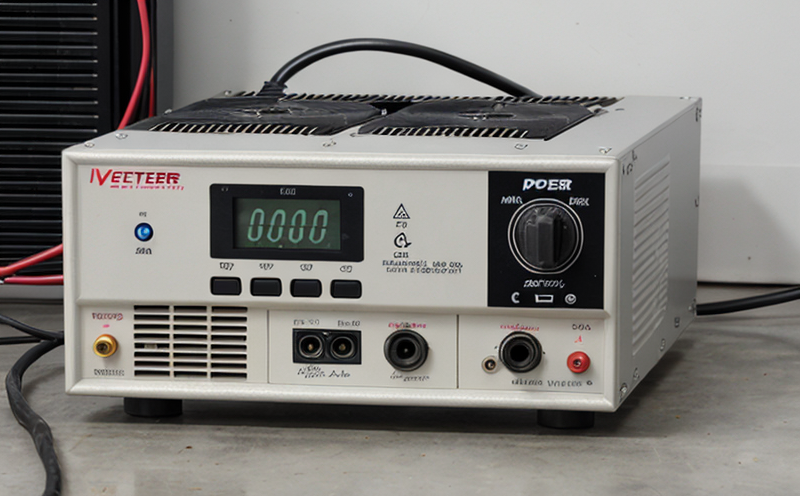EN 50178 Safety Testing of Electronic Equipment for Power Installations
The EN 50178 standard is a crucial document in the field of power electronics, specifically addressing the safety aspects of electronic equipment used in power installations. This standard ensures that all equipment designed to interface with the electricity supply complies with essential safety requirements as defined by European legislation and industry best practices.
The scope of EN 50178 is broad but focuses primarily on three main areas: protection against electric shock, protection against fire hazards, and the prevention of malfunctions that could lead to dangerous situations. The standard applies not only to inverters used in renewable energy systems like solar panels and wind turbines but also to other devices such as uninterruptible power supplies (UPS), motor drives, and battery management systems.
One of the key aspects of EN 50178 is its emphasis on the use of protective devices. These include fuses, circuit breakers, and residual current devices that are integral in safeguarding against electrical hazards. The standard provides detailed requirements for these components to ensure they function correctly under various fault conditions.
The testing process outlined in EN 50178 involves several stages aimed at assessing the performance and safety of electronic equipment under different scenarios. This includes evaluating the device’s resistance to overvoltage, overcurrent, and other transient faults that could occur during operation. The tests are conducted using specific test setups designed to mimic real-world conditions where the equipment might be deployed.
Another critical component of EN 50178 is its requirement for thorough documentation of all testing procedures and results. This ensures transparency and repeatability, allowing manufacturers and quality assurance teams to verify that their products meet safety standards consistently across multiple production runs. The documentation must include details such as the type of test apparatus used, the parameters tested, and the criteria against which the equipment is evaluated.
The standard also covers the use of appropriate test specimens for evaluation. These can range from small prototypes to full-scale models depending on the complexity of the device being tested. For instance, a solar inverter would require different specimen preparation compared to an industrial UPS unit. The test specimens must be representative of the final product and undergo all necessary modifications to reflect real-world conditions accurately.
When it comes to instrumentation for EN 50178 testing, accuracy is paramount. Instruments used should meet high precision standards to ensure reliable measurement results. Commonly used instruments include digital multimeters, oscilloscopes, and power analyzers. These tools are crucial in measuring key parameters such as voltage, current, power factor, and harmonic distortion.
The acceptance criteria for EN 50178 testing are stringent yet flexible enough to accommodate variations in equipment design. The standard sets limits on allowable deviations from nominal values and defines acceptable failure modes that do not compromise safety. Compliance with these criteria is essential for obtaining CE marking, which indicates conformance with all relevant EU directives.
In conclusion, the EN 50178 standard plays a vital role in ensuring the safe integration of electronic equipment into power installations. By adhering to this standard, manufacturers can demonstrate their commitment to quality and regulatory compliance, thereby enhancing trust among customers and stakeholders.
Benefits
The implementation of EN 50178 safety testing offers numerous benefits across various sectors:
- Enhanced Product Safety: Ensures that all electronic equipment meets stringent safety standards, reducing the risk of accidents and injuries.
- Regulatory Compliance: Helps manufacturers comply with European legislation, avoiding costly fines and potential legal issues.
- Market Access: Provides a competitive advantage by ensuring products meet international quality benchmarks, opening doors to new markets.
- Customer Trust: Builds confidence among consumers who value safety and reliability in their purchases.
Besides these advantages, compliance with EN 50178 also promotes innovation within the industry. By setting high standards for safety, manufacturers are encouraged to develop more advanced and efficient products that push technological boundaries while maintaining a focus on user safety.
Environmental and Sustainability Contributions
The principles underlying EN 50178 contribute significantly to environmental sustainability by promoting the use of safer technologies in power installations. For instance, inverters tested according to this standard are more reliable and less prone to failures that could lead to waste or pollution.
By ensuring that all electronic components used in renewable energy systems meet safety standards, EN 50178 helps reduce environmental impact associated with premature product failure. This leads to longer operational lifespans for power installations, resulting in better utilization of resources and reduced energy consumption during maintenance phases.
In addition, the standard’s emphasis on robust protective devices reduces the likelihood of fires or other hazards that could damage surrounding infrastructure or harm ecosystems. This not only protects human life but also helps preserve natural habitats affected by potential accidents involving power installations.
Competitive Advantage and Market Impact
Compliance with EN 50178 provides significant competitive advantages for manufacturers operating in the energy sector:
- Differentiation from Competitors: Meeting these stringent safety standards positions companies as leaders in product quality and reliability.
- Better Customer Relations: Satisfied customers are more likely to recommend your products, fostering positive word-of-mouth marketing.
- Premium Pricing Potential: Higher perceived value due to superior safety features can justify premium pricing strategies.
- Increased Brand Reputation: Consistently meeting international standards enhances brand reputation and strengthens market position.
In the highly competitive renewable energy industry, where trust in technology is paramount, compliance with EN 50178 helps establish a strong brand identity. This can translate into increased sales volumes as customers prioritize safety when making purchasing decisions.





